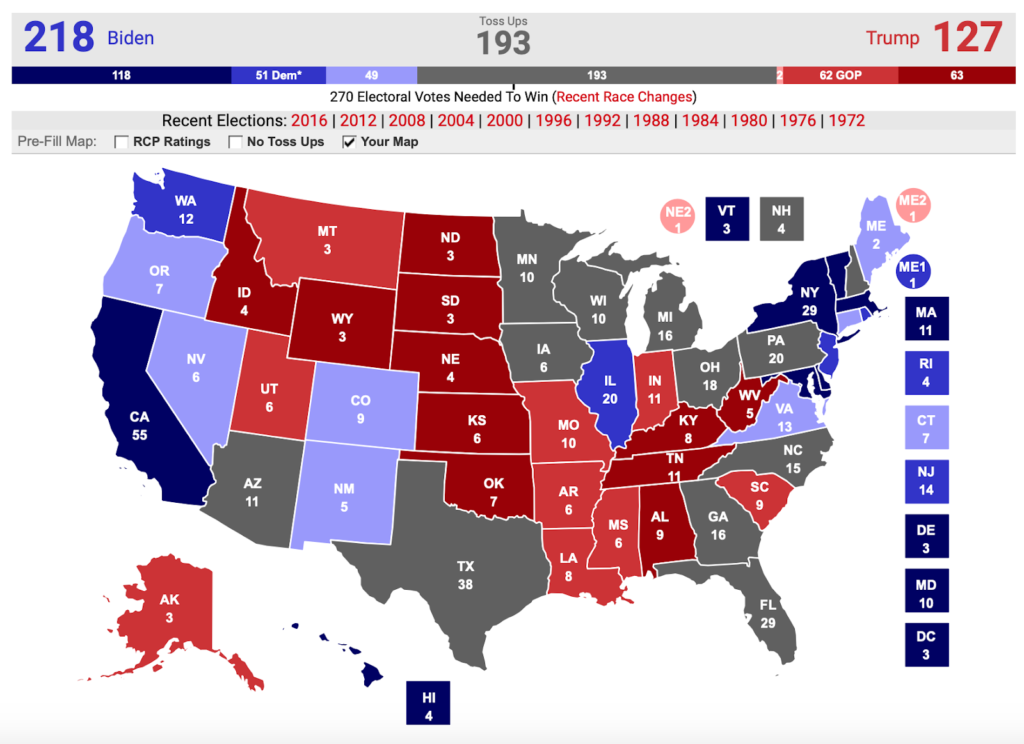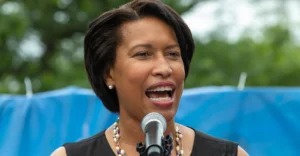Election 2020: Battleground Map Evolves As Polls Tighten

Image Courtesy of Real Clear Politics
By Justin Lamoureux
The summer is coming to a close. Both Democrats and Republicans have solidified their nominations at unprecedented “virtual” conventions. With less than two months remaining until Election Day, voters and experts alike could probably agree that “all systems are a go” for the general election campaign.
This election promises to be an interesting one, for reasons that have little to do with vote-by-mail or foreign interference. In recent weeks, the polls have tightened. The comfortable – if not solid – advantage that Democratic nominee Joe Biden maintained throughout the summer has weakened.
Biden and President Trump each enjoyed a brief statistical uptick from their respective party’s convention. This is typical – such a trend is commonly referred to as the “convention bump,” and is generally a result of extensive publicity surrounding the ticket and party. Trump never led the former vice president in a single poll, however. If anything, widespread coverage of Trump and the Republican National Convention shaved a few points off Biden’s lead.
A Real Clear Politics polling average from last week gives Biden a seven-point advantage over Trump. This is down from the nine-point edge he enjoyed in early July.
Notwithstanding a decrease in the former vice president’s average margin, levels of support for his candidacy have remained stagnant. In other words, this polling average has consistently shown Biden with 50 percent support. This is a positive sign for the Biden campaign as it suggests the Democratic candidate has a solid base of likely voters.
Conversely, Trump’s performance in the same polls has only improved during this time. The president has seen his average increase, from 41 to 43 percent support. This may seem like a small uptick – especially given how Biden maintains a steady lead – but it sends a clear message: This election is not over.
Don’t worry about national polls, though. The popular vote itself is significant, but it pales in comparison to the electoral college. Ultimately, several “battleground states” alone will decide this election.
The overall tightening of polls has resulted in two noteworthy developments: For starters, the electoral map has expanded to include an unprecedented number of battleground states. Among these states, the race has essentially become a dead heat. A recent SSRS poll – which oversampled roughly 15 so-called “swing states” – showed Biden ahead of Trump by a single percentage point.
There are approximately a dozen battleground states. For analytical purposes, this writer has divided them into two subcategories based on their merit: “key battleground” and “marginally competitive” states.
Key Battleground States:
Trump won all the “key battleground” states in 2016. These are the states which proved instrumental to handing the president an electoral college victory, despite a historically disproportionate loss of the popular vote.
Each state is likewise considered crucial to either candidates’ prospect of victory in this election. There is a high likelihood that at least one could end up being the “tipping point” state – in other words, the deciding factor – in this election. With that in mind, both Biden and Trump are expected to devote substantial time and resources to campaign in these states.
- Wisconsin
- Real Clear Polling Average: Biden + 4 (48% Biden, 44% Trump)
- 2016: Trump +0.8 (47.8% Trump, 47.0% Clinton)
- Michigan
- Real Clear Polling Average: Biden + 3 (47% Biden, 44% Trump)
- 2016: Trump +0.2 (47.6% Trump, 47.4% Clinton) *
*= In 2016, Michigan was the closest state of all.
- Pennsylvania
- Real Clear Polling Average: Biden + 4 (49% Biden, 45% Trump)
- 2016: Trump +0.7 (48.6% Trump, 47.9% Clinton)
- Florida
- Real Clear Politics Polling Average: Biden + 2 (48% Biden, 46% Trump)
- 2016: Trump +1.2 (49.0% Trump, 47.8% Clinton)
- North Carolina
- Real Clear Politics Polling Average: Biden +1 (48% Biden, 47% Trump)
- 2016: Trump +3.7 (50.5% Trump, 46.8% Clinton)
- Arizona
- Real Clear Politics Polling Average: Biden +5 (49% Biden, 44% Trump)
- 2016: Trump +3.5 (49.0% Trump, 45.5% Clinton)
Marginally Competitive:
- Minnesota
- Real Clear Politics Polling Average: Biden +4 (50% Biden, 46% Trump)
- 2016: Clinton +1.6 (46.9% Clinton, 45.3% Trump)
- Ohio
- Real Clear Politics Polling Average: Biden +2 (47% Biden, 45% Trump)
- 2016: Trump +8.1 (51.8% Trump, 43.7% Clinton)
- New Hampshire *
- Real Clear Politics Polling Average: Biden +10 (52% Biden, 42% Trump)
- 2016: Clinton +0.4 (47.6% Clinton, 47.2% Trump)
*= In 2016, New Hampshire was the closest state that Trump LOST.
- Iowa
- Real Clear Politics Polling Average: Trump +2 (47% Trump, 45% Biden)
- 2016: Trump +9.5 (51.7% Trump, 42.2% Clinton)
- Texas:
- Real Clear Politics Polling Average: Trump +4 (47% Trump, 43% Biden)
- 2016: Trump +9.0 (52.5% Trump, 43.5% Clinton)
- Georgia:
- Real Clear Politics Polling Average: Trump +1 (46% Trump, 45% Biden)
- 2016: Trump +5.1 (51.0% Trump, 45.9% Clinton)
Battleground states themselves might yield immense leverage over the outcome of this election, but within these states, nothing has more sway than individual demographics. Both Trump and Biden have specific groups of voters among whom an exceptionally strong performance will prove vital to their electoral success. Said demographics – and their significance – are further evaluated below:
Trump’s Key Demographics:
White Evangelical Christians
The so-called “religious right” has long been a bedrock of support for the Republicans. Since the Reagan era, conservative attitudes regarding topics such as abortion have compelled Evangelical Christians, in particular, to vote for the party in droves. Trump won Evangelical voters by 65 points in 2016, and a recent Pew Research Center poll – which has him leading by 61 points – suggests he is on track to win this demographic by a similar margin this year.
Votes from the “religious right” will likely carry the most weight in four battleground states: Texas, Georgia, Pennsylvania, and Iowa. These are known to have higher than average populations of White Evangelicals, especially in more rural areas.
Non-College Educated White Voters
For decades, White-Working Class voters were among the most reliably Democratic voters. The heavy influence of labor unions in elections carried nearly every Democratic president of the twentieth century to the White House. In recent years, however, the overall decline of the manufacturing industry (and decline of labor unions) has prompted the blue-collar electorate to take a sharp turn right.
Exit polls conducted by CNN suggest that 66 percent of non-college white voters broke for Trump in 2016. This is on par with a recent Pew Research poll, which pinpoints his support among this key demographic at 61 percent (compared to 36 percent for Biden). In terms of battleground states, white-working class support will probably have the largest impact on results in the six Midwestern (or “Rust Belt”) states on this map: Michigan, Wisconsin, Pennsylvania, Ohio, Iowa, and Minnesota. These are the states with the highest concentration of non-college white voters, and specifically, blue-collar workers. In an unexpectedly close race, Trump (or Biden)’s prospects may hinge on his ability to retain (or peel away) a few extra percentage points among this group of voters.
Rural voters
Rural voters have long been a defining presence in the GOP. In 2016, Trump benefited from record turnout in rural areas, prompted in large part by his rhetorical appeal to a disaffected element of American society. While this regional demographic will almost certainly remain a solid feature of the GOP base in November, there are subtle reasons for concern: While Trump won the rural vote by 25 points in 2016, a recent poll by Fox shows the president ahead by only single digits.
Another recent survey conducted by The Gazette – a local newspaper in Iowa – offers the Trump campaign additional foreboding: It showed that 54 percent of rural voters across four Midwestern states (including some key battlegrounds) feel more negatively about the president than they did four years ago. Granted, rural voters have a role to play in all battleground states; if support for Trump is down in key battleground states in a potentially decisive region, however, this could prove detrimental to his re-election prospects.
It should be noted, however, that Trump did not manage to secure victories in battleground states by racking up wide margins among his base alone. He did so by overperforming among certain demographics which both polls and experts anticipated would favor Hillary Clinton and the Democrats, including:
- Suburban Women
- African-Americans (especially men)
- College-educated voters
If Trump wants to win re-election, winning a similar number of votes – or a comparable percentage – among these groups will be essential to his doing so.
Biden’s Key Demographics:
African-Americans
African-American voters have become a defining feature of the modern Democratic Party. Conventional wisdom is that Democrats need to win at least 90 percent of the black vote to win elections – Just one point higher than Clinton’s 2016 vote share. Despite selecting Senator Kamala Harris (a woman of color) as his running mate, Biden continues to underperform among African-American voters in polls – His average level of support is 83 percent.
While time remains between now and Election Day, this indicates that Biden is under increased pressure to bolster his support among black voters. The African-American vote will play a pivotal role in all battleground states, but wherein these states depend on the specific region.
In midwestern states, for instance, black communities are concentrated almost entirely in major cities, like Detroit or Milwaukee. In most southern states, the African-American population is far more widespread and maintains a presence on the peripheries of both urban and rural areas.
Latinos
In general, the Latino electorate is exceedingly diverse. A broad array of ethnicities, ideologies, and socioeconomic backgrounds, make the demographic itself fairly competitive. This is especially true in the battleground state of Florida, where Trump received 35 percent of the Latino vote in 2016. This is significantly higher than his national performance among the constituency; CNN exit polls projected that 28 percent of Latino voters supported the president.
There is also reason to believe that Trump’s popularity among Latinos has increased since 2016 – His current polling average is 33 percent. Besides Florida, if the Latino vote was going to pull Biden over the finish line in any battleground state, it would undoubtedly be Arizona or Texas. In these two states, the Hispanic electorate is solidly Democratic, and as such would be more likely to turn out for Biden.
If Democrats are going to win in November, they need to remember one important thing: Trump does NOT need to win the African-American or Latino vote to win, period. If he peels away a certain percentage from Biden – basically anything above 10 percent with the former or 30 percent with the latter – this could easily jeopardize the election for Democrats. Granted, recent polls show that Biden has been making inroads with white voters – This has the potential to offset a smaller-than-expected margin among voters of color (especially in states like Michigan or Pennsylvania) but is by no means something that Biden can depend on.
Voters under the age of 45 (i.e., Millennials and Gen – Z).
Younger voters will define the future of the Democratic Party. Trump is not the first Republican to struggle with them, either – The GOP has long failed to reach the cusp of viability with these increasingly mobilized demographics (a fact many Republican politicians and strategists underscore). Biden also has reason to be optimistic – A recent New York Times/Siena poll shows him ahead by 34 percent with voters under the age of 45. Hillary Clinton, by comparison, won this age group by only 14 points in 2016.
Widespread unfavorability of Trump does not necessarily equate to sufficient turnout for Biden, though. If Biden wants to have a serious chance of winning, he needs to demonstrate to both Millennial and Generation Z voters – through his outreach and platform – that he is receptive to their concerns, and will ensure they are properly represented, in his administration.
Women
President Trump’s relative unpopularity among women is self-evident. By the same token, Biden has made a conscious effort to capitalize on this. His selection of Senator Kamala Harris for the vice-presidential nomination was largely seen as a move to court female voters; specifically, women of color. During the primary season, African – American women played a critical role in helping to revive Biden’s faltering campaign; his wide margins among this group helped him secure victories in early-voting states like South Carolina.
The Biden campaign also hopes that Harris’ presence on the ticket will galvanize women from demographics which have only begun to trend Democratic in recent years. College – educated white women constitute the optimal paradigm; In 2016, Hillary Clinton won 51 percent of voters in this group, becoming the first Democrat to receive such a majority at the presidential level. In many respects, this election will serve as a “litmus test” of Democrats’ strength among women from more affluent backgrounds… and the ideological direction in which these voters are moving.
Suburban Voters (especially college-educated whites).
Traditionally, the suburbs have been a political firewall for Republicans. In recent years, however, evolving demographics have led to many suburban communities gravitating towards the Democratic Party. What’s more, Biden is believed to have an unprecedented advantage with suburban voters – A recent ABC News/Washington Post poll showed the former Vice President with a 15-point lead (55 – 40) among this demographic. Chances are, if Biden wins this election, it will be in large part because he won these kinds of margins in the suburbs of Philadelphia, Detroit, or Charlotte.
Of course, these statistics must be taken with a “grain of salt” – In 2016, Trump received a higher percentage of suburban voters than a majority of polls anticipated (in fact, these voters are suspected to comprise the bulk of “secret” Trump supporters). With that in mind, if Trump does defy the polls and win a second term, it will quite possibly be thanks to slim margins of victory (or defeat) in some key suburban precincts.
What do these numbers mean? Well, on the surface, Biden’s “upper hand” is implicit. Keep in mind, however, that polls are simply statistics. Their outcome depends entirely on who picks up the phone, clicks an ad that pops up on the screen of their computer or answers a survey via email. Not to mention, almost two months remain before Election Day – The numbers can (and likely will) change a lot during that time.






